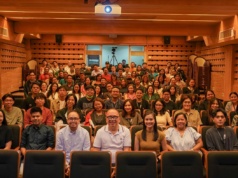November 30, 2014 9:37 pm
by TITA C. VALDERAMA
FILIPINOS are skillful and creative; no doubt about that. We have so many great talents in various fields that have made us proud as Filipinos. They make names not only for themselves but for the Philippines as well.
However, we often hear complaints that they have not been getting adequate support from government. Perhaps they would have performed better had they been given moral and financial support in pursuing their activities.
It’s sad that the Philippines is at the bottom among 39 countries in terms of labor productivity of Copyright-Based Industries (CBIs) while it is on top, along with Mexico, in terms of employment generation.
What are these CBIs, you may ask. For sure, we are all too familiar with these but we may not know these as being categorized as copyright-based industries. These are also called “creative industries.”
Well, these are industries involved in the press and literature; music, theatrical productions, operas; motion pictures and videos; radio and television; photography; software and data bases; visual and graphic arts; and advertising services.
These industries involve not only artists, entertainers, painters, composers and the like, but also those in the newspapers, books, magazines, periodicals, etc…everybody whose work involves copyright.
Why is there a disconnect between the CBIs’ ranking on employment generation and productivity? We are not high-tech enough to be productive and competitive because the industries do not have sufficient capital and support from the national government, according to lawyer Ricardo Blancaflor, director general of the Intellectual Property Office of the Philippines (IPOPHL).
“The government should appreciate that the creative industry is a valuable industry,” said entertainer Mitch Valdez. Given enough financial push, she said the industry could make bigger money for the country. “We have been banging doors and the corridors of government, but our cries fell on deaf ears,” she lamented.
According to Blancaflor, it was sad that the Philippines lost to Myanmar in a recent animated films competition held in Bangkok, given that Myanmar does not even have an IPO agency.
A lady from the animation sector who was a judge in the competition said Myanmar’s entry was indeed amazing. The Myanmar content creators came well prepared with government support while the Filipinos were, in her words, “kanya-kanya.”
Filipino animators produce quality work. If not, they would not have been outsourcing content for international producers like Disney, Nickelodeon, and Animal Planet. In other Asian countries such as Thailand, Singapore, and Korea, animators are given seed money and government aggressively promotes their work.
Blancaflor and the people in the creative industries have reason to complain that government support is wanting.
Last Wednesday, IPOPHL made public the result of a four-year study on the overall economic contributions of the CBIs to the country. The result showed that CBIs have become significant economic drivers with 7.34 percent contribution in the Gross Domestic Product (GDP) equivalent to P661.23 billion, from 4.82 percent shown in a 2006 study with 1999 as base year.
The study, using 2010 as reference year, identified relevant industries and estimated their value-added share in the country’s GDP, employment, and trade. The economic indicators were measured using the World IPO (WIPO) Guide on surveying the economic contributions of the CBIs, according to Emma C. Francisco, leader of the study group and former director general of IPOPHL. It, however, did not take piracy into account.
The study also did not include new media to be consistent with the findings of the previous study and the WIPO guidelines, Francisco said.
The study showed CBIs’ contribution to the labor force or employment has grown to 14.4 percent, or an estimated 560,665 jobs created for Filipinos, from 11 percent or 317,000 employment opportunities in 2006.
On trade, CBIs exports are estimated at 3.06 percent of the country’s total exports while imports were at 0.81 percent. This shows that CBIs are indeed engines of growth.
Given the significant contribution of the creative industries to the economy, actor/comedian/ director Leo Martinez said the actual situation has been unpleasant to the creative sectors.
He cited the case at GMA Network where more than a hundred workers classified as talents risk losing their jobs by the end of the year after they demanded to be regularized and entitled to the standard employee benefits like 13th month pay, leave credits, health insurance, among others.
The situation, Martinez said, shows little regard for the creative workers not only by government but also by big media networks.
Valdez lamented that many Filipinos show condescending behavior toward entertainers. “The attitude is ‘showbiz ka lang’,” she noted. She suggested that government agencies help encourage investors and business leaders to explore the viability of the creative industries.
Source: The Manila Times






























